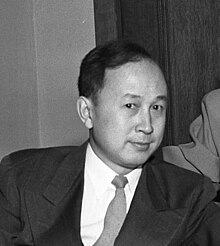
Back تشيان شيويه سن Arabic Čchien Süe-sen Czech Qian Xuesen Danish Qian Xuesen German Qian Xuesen Spanish Qian Xuesen Estonian چن شیسن Persian Qian Xuesen Finnish Qian Xuesen French Qian Xuesen Galician
Qian Xuesen | |||||||||||
|---|---|---|---|---|---|---|---|---|---|---|---|
钱学森 | |||||||||||
 Qian in 1950 | |||||||||||
| Born | 11 December 1911 | ||||||||||
| Died | 31 October 2009 (aged 97) | ||||||||||
| Nationality | Chinese | ||||||||||
| Alma mater |
| ||||||||||
| Known for |
| ||||||||||
| Spouse | |||||||||||
| Children | Qian Yonggang Qian Yungjen | ||||||||||
| Awards |
| ||||||||||
| Scientific career | |||||||||||
| Fields | |||||||||||
| Institutions |
| ||||||||||
| Theses | |||||||||||
| Doctoral advisor | Theodore von Kármán | ||||||||||
| Doctoral students |
| ||||||||||
| Chinese name | |||||||||||
| Traditional Chinese | 錢學森 | ||||||||||
| Simplified Chinese | 钱学森 | ||||||||||
| |||||||||||
| Signature | |||||||||||
 | |||||||||||
Qian Xuesen (钱学森; 11 December 1911 – 31 October 2009; also spelled as Hsue-shen Tsien) was a Chinese aerospace engineer and cyberneticist who made significant contributions to the field of aerodynamics and established engineering cybernetics. He achieved recognition as one of America's leading experts in rockets and high-speed flight theory.[1]
Qian received his undergraduate education in mechanical engineering at National Chiao Tung University in Shanghai in 1934. He travelled to the United States in 1935 and attained a master's degree in aeronautical engineering at the Massachusetts Institute of Technology in 1936. Afterward, he joined Theodore von Kármán's group at the California Institute of Technology in 1936, received a doctorate in aeronautics and mathematics there in 1939, and became an associate professor at Caltech in 1943. While at Caltech, he cofounded NASA's Jet Propulsion Laboratory.[1][2] He was recruited by the United States Department of Defense and the Department of War to serve in various positions, including as an expert consultant with a rank of colonel in 1945. At the same time, he became an associate professor at MIT in 1946, a full professor at MIT in 1947, and a full professor at Caltech in 1949.[3]
During the Second Red Scare in the 1950s, the United States federal government accused him of communist sympathies. In 1950, despite protests by his colleagues and without any evidence of the allegations, he was stripped of his security clearance.[1][4] He was given a deferred deportation order by the Immigration and Naturalization Service, and for the following five years, he and his family were subjected to partial house arrest and government surveillance in an effort to gradually make his technical knowledge obsolete.[1] After spending five years under house arrest,[5] he was released in 1955 in exchange for the repatriation of American pilots who had been captured during the Korean War. He left the United States in September 1955 on the American President Lines passenger liner SS President Cleveland, arriving in mainland China via Hong Kong.[6]
Upon his return, he helped lead development of the Dongfeng ballistic missile and the Chinese space program. He also played a significant part in the construction and development of China's defense industry, higher education and research system, rocket force, and a key technology university.[7][8][9][10][11] For his contributions, he became known as the "Father of Chinese Rocketry", nicknamed the "King of Rocketry".[12][13] He is recognized as one of the founding fathers of Two Bombs, One Satellite.[14]
In 1957, Qian was elected an academician of the Chinese Academy of Sciences. He served as a Vice Chairman of the National Committee of the Chinese People's Political Consultative Conference from 1987 to 1998.
He was the cousin of engineer Hsue-Chu Tsien, who was involved in the aerospace industries of both China and the United States. His nephew, Roger Y. Tsien, was the 2008 winner of the Nobel Prize in Chemistry.
- ^ a b c d https://www.jpl.nasa.gov/universe/archive/un0911.pdf
- ^ "Qian Xuesen - Nuclear Museum".
- ^ "Biographies of Aerospace Officials and Policymakers". NASA. Archived from the original on 11 June 2022. Retrieved 2 February 2015.
- ^ Perrett, Bradley; Asker, James R. (7 January 2008). "Person of the Year: Qian Xuesen". Aviation Week and Space Technology. 168 (1): 57–61. Archived from the original on 8 December 2015. Retrieved 2 February 2015.(subscription required)
- ^ "Tsien Hsue-Shen Dies". Caltech. 2 November 2009. Archived from the original on 12 June 2010. Retrieved 2 February 2015.
- ^ "US Deporting Rocket Expert". St. Louis Post-Dispatch. 13 September 1955. Archived from the original on 24 July 2023. Retrieved 28 April 2023.
- ^ "钱学森:毕生为强国----中国科学院". www.cas.cn. Archived from the original on 2023-03-05. Retrieved 2023-03-05.
- ^ "钱学森与中国科学技术大学----中国科学院". www.cas.cn. Archived from the original on 2020-04-05. Retrieved 2023-03-05.
- ^ "钱学森关于教育问题的一次谈话". zqb.cyol.com. Archived from the original on 2023-03-05. Retrieved 2023-03-05.
- ^ "科学技术体系学研究的开创者----中国科学院". www.cas.cn. Archived from the original on 2023-03-05. Retrieved 2023-03-05.
- ^ ""火箭军"之名从哪儿来:1956年元旦由钱学森提出_私家历史_澎湃新闻-The Paper". www.thepaper.cn. Archived from the original on 2020-11-04. Retrieved 2023-03-05.
- ^ "钱学森:历尽险阻报效祖国 火箭之王淡泊名誉" [Qian Xuesen: King of Rocketry who experienced obstacles in serving the Motherland]. 人民网 (People.com.cn) (in Chinese). 31 October 2009. Archived from the original on 3 March 2016. Retrieved 31 October 2009.
- ^ "美国航空周刊2008年度人物:钱学森" [US Aviation Week & Space Technology Person of the Year 2008: Qian Xuesen]. 网易探索(广州) (in Chinese). 31 October 2009. Archived from the original on 3 November 2009. Retrieved 11 November 2009.
- ^ "23位两弹一星元勋已有17人离世 媒体解析其功绩". China.com (in Chinese). 30 May 2016. Archived from the original on 31 August 2018. Retrieved 31 August 2018.